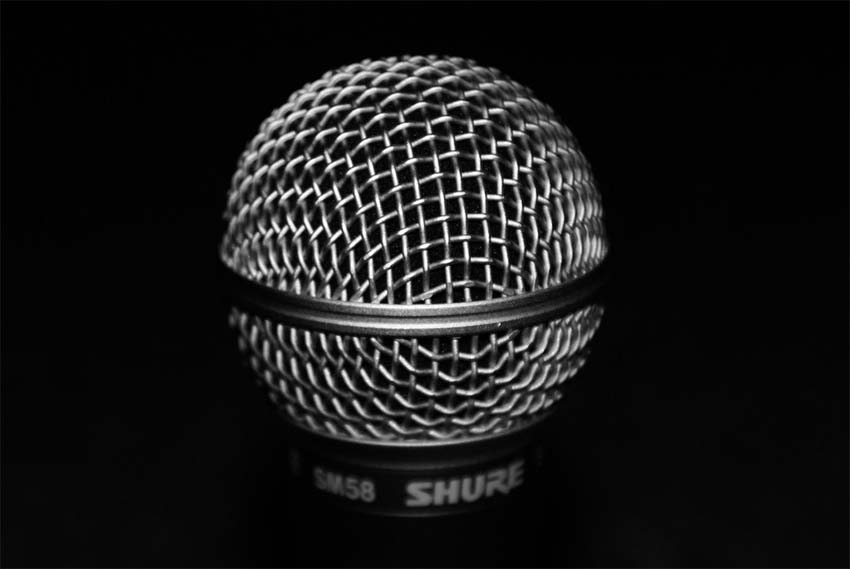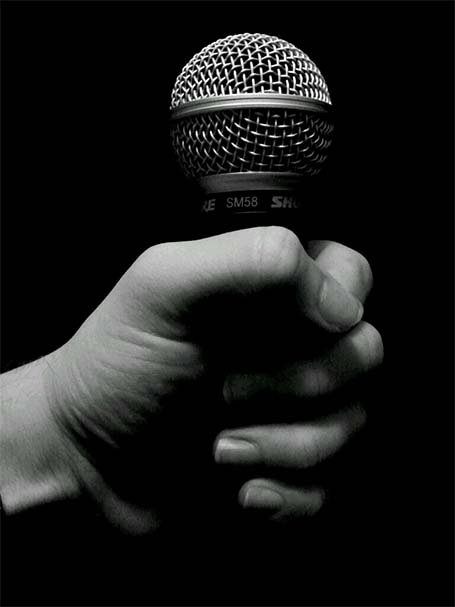It may have been your first mic, or it may be the one you’ll use at the gig tonight — either way, this mic set the standard for nearly every microphone built in the last 50 years. Shure’s SM58 leads the way in the live sound microphone world thanks to years of refinement and development updates, setting the pace for the industry as a whole. But how did a microphone that wasn’t even intended to be used on stage get to the head of the pack? Let’s take a look at the history of the Shure SM58.

Early years and what does SM mean?
The broadcast boom of the 1940s-60s was a golden age for microphone engineering. But once television took center stage, the chrome large-diaphragm microphones that were so popular on radio were just too shiny for the bright lights and too delicate for the overall demands of television. This led the Shure company to create the “perfect” microphone for a live television studio. The SM58, or “studio microphone” 58 was first produced in 1966 to fill this need.
The SM58 claims a lot of firsts — it was the first microphone to have an attached windscreen. This screen is the internal lining of the wire dome, which acts as a “crumple zone” in the event of a drop to protect the transducer inside.
Initially, the SM58 was received poorly, with sales between 1966 and 1970 capping out at an average of just 1 to 2 units a day. This led a Shure vice president in 1970 to attempt to discontinue the microphone. This was until Sales Manager Roger Ponto offered a solution. Ponto’s idea was to visit many of the major hotels and show houses in Las Vegas and provide the SM58 as a live performance microphone. His plan was to continue to market the SM58 as a performer’s tool in stage production at the lavish stage shows on the Las Vegas strip.
At the time, many live performance microphones featured large diaphragms which made them prone to feedback at stage volume. This is why many performers and artists throughout the ’30s, ’40s and ’50s would stand in a single place on stage.

Once sound engineers began to see how a performer could move around on stage while using the SM58, many became interested in what Shure was offering. The Sahara and Sands casinos were the first to come onboard with Shure, and the SM58’s reputation began to take shape as the live sound darling we love today.
Shure wasn’t done either — each year they would send a grip of repair technicians to Las Vegas and host a Shure repair clinic. Any hotel, casino or stage show that used Shure products could get their equipment repaired for free at these clinics; this increased brand loyalty and marketed the great customer service of the Shure brand.
A Famous “Flop”
The SM58 we know today was actually a mistake in the eyes of its creator, Ernie Seeler. Seeler was attempting to create a microphone that had a completely flat frequency response. The SM58 has a response that features a presence peak beginning around 1KHz and peaks around 7-8KHz then dips. This peak is now referred to as the “Shure voice,” and it brings out the vocals in a live mix.

Seeler considered the SM58 a flop, however, and went on to create the SM59, which was a flat-response dynamic microphone. These microphones flopped. In one famous example, Frank Sinatra was provided an SM59 during a rehearsal at Caesar’s Palace where mid-song, he threw the microphone across the stage and demanded his SM58 back for the show. The dented SM59 was given back to Shure with the feedback “Frank didn’t like it.”

Updates that made it “The Great 58”
Even a microphone as storied and consistent as the SM58 needs to adapt to the times. Shure historian Michael Pettersen estimates that the Shure SM58 has gone through anywhere from 40-50 changes in components throughout the years. This is mainly due to the microphone outliving its suppliers, but some changes were made for the sake of longevity, too.
Some major updates include the change from dual low-impedance ratings to a single low-impedance rating. The original SM58 carried both 150 ohm and 50 ohm impedance ratings due to broadcast standards of the time. In the mid-twentieth century, broadcast microphones were typically wired directly into low-impedance faders and matching a 50ohm standard impedance was important to drive sales to this demographic. Now that these standards are no longer in place, Shure has switched to a single 150 ohm impedance in each mic.

The SM58 internal acoustical resistance material was also updated to synthetic fabric from wool cloth. The wool would change acoustically when wet or stretched in any way. The change to manufactured synthetic material improved the consistency of each microphone.
Though many changes to the SM58 are public, many are not due to the hike in competition and illegal counterfeiters over the years.
The Shure SM58 leads the way to this day because Shure refused to give up on it and continues to support it year in and out. From its humble beginnings barely holding on, to the stages of Las Vegas and beyond, the SM58 never stopped and never will.





Leave a Reply